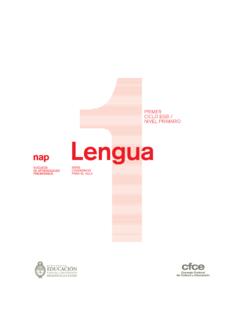Transcription of Common Core ELA Parent Overview: Grades 3-5
1 OptionalSurveyWe d like to hear from those who access this CA Standards document. We invite you to participate in a brief survey: an emphasis on developing comprehension with texts, students are exposed to a variety of literature and informational texts and learn how different genres, or types, of books have different structures. Students are encouraged to read, read, read and to expand their knowledge in areas of personal interest or new research topics. They begin to develop ana-lytical skills, going beyond stating explicit information from the text to learning how to draw inferences and how to summarize what they read. In Grades three through five, students are becoming more sophisticated writers and speakers. These skills include engaging in research projects that question what they read and hear, taking information and putting it into their own words, and creating written pieces that follow a structure geared toward a writing purpose ( , a narrative story, an informational report, or an opinion text).
2 Classrooms allow children to explore new topics using books, videos, and technology and participate in interactive, collaborative activities with teachers and Comprehension and Writing SkillsGrades 3 5 What Your Student Will Learn: Make books special give them as gifts, take your student to the library to explore different types of books, read with your student, create a cozy place for reading and writing, or introduce your student to a book series or your favorite children s book author. Play word games with your student in the car, ask your student to summarize a favorite episode from a video or book, and start a conversation with your student and encourage him or her to ask questions and share opinions about a more information on the California Common Core State Standards for ELA/Literacy and ideas for helping your student succeed, check out these resources: The Common Core Resources Web page is available online at Start by clicking on the Students/Parents tab.
3 The California Common Core State Standards for ELA/Literacy are available online at The ELA/ELD Framework for California Public Schools is available online at Produced for the Consortium for the Implementation of the Common Core State Standards under the leadership of the Curriculum Frameworks and Instructional Resources Division of the California Department of Education and the Sacramento County Office of help your student develop literacy skills:California Common Core State Standards for ELA/LiteracyStudents engage in new and challenging literacy experiences as they develop skills and knowledge under the California Common Core State Standards for English Language Arts/Literacy. The standards are organized around four strands Reading, Writing, Speaking and Listening, and Language which define what students are expected to learn by the end of each grade .
4 Students in Grades three through five build on their foundational reading skills by improving their reading fluency and decoding longer and more difficult words. Learning also focuses on three new emphases: (1) more exposure to content-rich informational texts; (2) developing and writing opinions using evidence from books and other text resources; and (3) engaging in group and individual reading and research activities centered on more complex texts with new Skills Language Development Content Knowledge Meaning Making Listening Speaking Meaning Making Effective Expression Language Development Foundational Skills Language Development Content Knowledge Meaning Making Listening Speaking Meaning Making Effective Expression Language Development Foundational Skills Language Development Content Knowledge Meaning Making Effective Expression Reading WritingListening Speaking Meaning Making Effective Expression Language Development Foundational Skills Content Knowledge Students continue to critically analyze and reflect how what they read impacts their comprehension.
5 This table shows some of the skills in the Reading Standards for Literature that students learn by the end of each of Making Meaning with Text3 Students distinguish their own point of view from that of the narrator or those of the compare and contrast the point of view from which different stories are narrated, including the difference between first- and third-person narrations. 5 Students describe how a narrator s or speaker s point of view influences how events are described. Analysis of TextDeveloping Language SkillsSpeaking and Listening SkillsTo support their reading, writing, and use of language, students continue to strengthen their vocabulary and grammar through the Language Standards. Learning to identify and understand word relationships and nuances in word meanings is critical. This includes knowing general academic words (used in all sorts of texts and subject areas) and content-specific words (important to understanding specific topics or field of study).
6 As part of their development of understanding, students in this grade span distinguish the literal and non-literal meanings of words and phrases in context ( , take steps) (Third grade ); explain the meaning of simple similes and metaphors ( , as pretty as a picture), in con-text (Fourth grade ); interpret figurative language, including similes and metaphors ( , the clouds sailed across the sky) in context (Fifth grade ).Speaking and listening skills are important for communication. Students continue to build their skills through collaborative conversations on grade - level topics and texts. In addition, students work on improving comprehension in the following Listening Comprehension3 Determining the main ideas and supporting details of a text read aloud or information presented in diverse media and formats, including visually, quantitatively, and portions of a text read aloud or information presented in diverse media and formats, including visually, quantitatively, and orally.
7 5 Summarizing a written text read aloud or information presented in diverse media and formats, including visually, quantitatively, and Skills Language Development Content Knowledge Meaning Making Effective Expression Reading WritingListening Speaking Meaning Making Effective Expression Language Development Foundational Skills Content Knowledge







